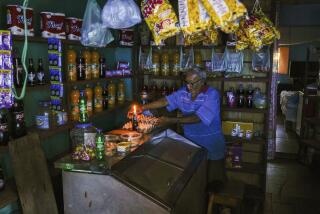Leftist Guerrilla Sabotage Puts Out Lights, Cripples Industry in Peru
- Share via
LIMA, Peru — Almost every night, in a deserted field or on a mountainside, a charge of dynamite goes off and Peruvians’ lights go out.
The sabotage of high-tension pylons by leftist guerrillas who call themselves, ironically, the Shining Path is plunging Peruvians into darkness and cutting dangerously into the nation’s industrial output.
Power rationing has become a daily headache for millions of people in Lima and other major cities that depend on hydroelectric power that is brought over the Andes.
Lima has a new sound--the almost constant hum of thousands of portable gasoline generators.
Its streets are in almost constant gridlock because traffic lights are out. Restaurants and house wives complain of food spoiling because refrigerators aren’t working.
Landlords are slashing rents for the upper floors of high-rise apartment buildings to entice renters worried about climbing the stairs when elevators stop.
Since July 28, 1980, when the first high-tension pylon was blown up in the mountains near Ayacucho, 235 miles southeast of Lima--as President Fernando Belaunde Terry was giving his state-of-the-union address--1,205 towers have fallen, according to the state power company Electroperu.
A total of 335 were felled last year alone and more than 100 have been toppled since municipal elections in November, when the rebels blew up 80 in one week in an effort--largely unsuccessful, as it turned out--to disrupt the voting.
The rainy season that lasts from January to May in the Highlands is making it difficult for repair crews to reach toppled towers, and Electroperu says it does not know how long power rationing, which began in mid-November, will continue.
“The whole system is a shambles,” said Jose Dibos of the National Industrial Society. “We are running into an almost continuous situation where power outages have to be accepted as a way of life.”
The Shining Path took up arms in 1980 to bring down Peru’s elected government and install a peasant-worker state patterned on the ideas of Mao Tse-tung of China.
The government said more than 17,500 people have died in the violence and economic costs have surpassed $15 billion.
Damage to the electrical system has cost the country more than $600 million, including repairs and lost electrical output, according to Electroperu. The company said it costs about $20,000 to replace a tower.
The Industrial Society’s Dibos said the electric company has been able to maintain a “precarious balance” only because industries are operating at 50% of capacity due to the country’s economic problems, which included 2,775% inflation last year and a 12% drop in the gross domestic product.
But he said the damaged power grid is a “time bomb” that is costing industry millions of dollars in lost production and ruined materials and equipment.
One of the hardest hit areas is the glass industry, whose ovens need a continuous supply of power to allow for the slow heating and cooling required to make glass.
The Industrial Society said glass production has dropped by half.
“It’s almost impossible for an industrial user to predict when he is going to get power and for how long,” Dibos said.
Most of the power supplied to Lima, where a third of Peru’s 22 million people live, comes from Electroperu’s hydroelectric dam on the Mantaro River in a mountain valley 165 miles east of Lima.
Three interconnected lines carry power over the Andes to the coast, each passing through guerrilla country. One of the three has been down since 1987, when Electroperu withdrew its repair crews after guerrillas burned 10 company trucks and threatened to kill workers if they returned.
An Electroperu spokesman, Jose Acevedo, said repair crews on the other two lines know they are being watched.
“They watch them from a distance, and as soon as they finish raising a tower, the terrorists come in and blow up another one,” he said.
Acevedo said one tower was felled six times before the army strung barbed wire and planted land mines around it.
More to Read
Sign up for Essential California
The most important California stories and recommendations in your inbox every morning.
You may occasionally receive promotional content from the Los Angeles Times.










